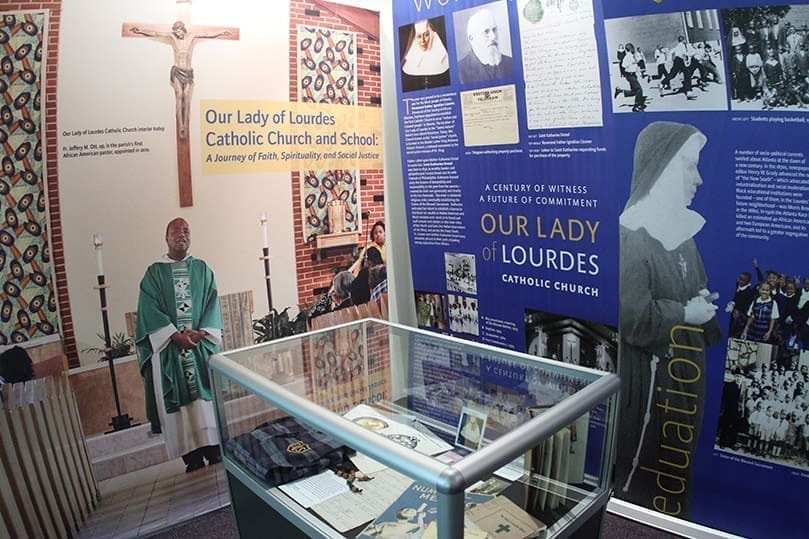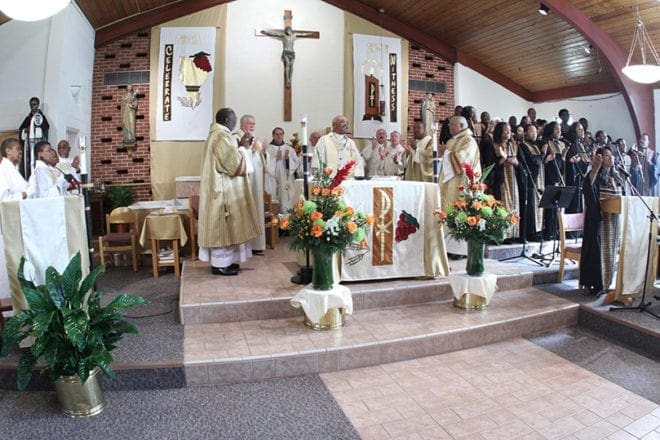 Photo By Michael Alexander
Photo By Michael AlexanderAtlanta
Lourdes At 100: ‘Irrefutable Sign’ Of God’s Reign
By GRETCHEN KEISER, Staff Writer | Published December 6, 2012
When the mission was planted 100 years ago in Atlanta’s Old Fourth Ward, it was small, not powerful, yet caused consternation by simply being there.
Our Lady of Lourdes Church and School began with 15 people, the first black Catholic church in Atlanta when Catholic churches, like other institutions in the community, were segregated.
A determined priest, Father Ignatius Lissner, of the Society of African Missions, and a sister, Mother Katharine Drexel, who dedicated her inheritance and the religious community she founded to establishing missions for blacks and Indians, worked together to start Our Lady of Lourdes so that black Catholics could have a church to worship in and a Catholic school for their children.
First designated for the Highland neighborhood of Atlanta, Father Lissner had to find a new location because of the uproar there that a Catholic church for blacks would be opened.
He found a new place on Boulevard and wrote Mother Katharine of his good fortune in finding this piece of property for $13,000. With her help, that of the bishop of Savannah, Bishop Benjamin Keiley, whose diocese included Atlanta, and of attorney J.J. Spalding, a parishioner at Sacred Heart Church in Atlanta, he was able to buy the property.
The stone and brick three-story building was put up in 1912, with the church on the ground floor, the school on the second floor, administered by Mother Katharine’s Sisters of the Blessed Sacrament beginning in 1913, and a parish hall on the third floor.
The building is solidly there today, along with the parish church added in 1961, but, as Archbishop Wilton D. Gregory said, with emotion, they are there because of the workings of God’s providence over the last century.
“The founding members of this community are so proud of you, as am I,” he said on Sunday, Nov. 18, as he celebrated the centennial Mass at Our Lady of Lourdes Church, the third Mass of the day, and every pew was filled with congregants.

Ninety-year-old Sally Davenport has been attending Our Lady of Lourdes since 1948. Photo By Michael Alexander
“When Our Lady of Lourdes Catholic Church was established 100 years ago, I suppose that few people at that time would have imagined that it might ever be more than a modest little Catholic church where black people could worship since we were not then welcomed to worship in the other Catholic churches in Atlanta at that time,” he said.
“It was to be a quiet establishment that had little influence or impact on life in Atlanta at the time or for that matter in the future,” he said.
“But Our Lady of Lourdes was an irrefutable sign that the reign of God was being born and that Atlanta itself would be changed in that birthing.”
Father Lissner, Mother Katharine, Bishop Keiley, Spalding, he said, “were simply doing what they believed to have been the right thing to do at the time, but because of them and the perhaps even more courageous and devout pioneer black Catholic families, Our Lady of Lourdes Catholic parish was born and God’s reign was advanced,” Archbishop Gregory said.
“Those pioneer black Catholics who gave Our Lady of Lourdes both life and hope are the real heroes and heroines of this centennial,” he said. “Those faithful Christian people validated all of the generosity and pastoral zeal of the benefactors whose bravery and kindness launched this wonderful community.”
Looking around the church, Our Lady of Lourdes is obviously a place where many different Catholics feel at home. Over 1,000 families are registered there, according to the pastor, Father Jeffery Ott, a Dominican priest and the first African-American pastor, and they come from over 160 zip codes around Atlanta.
History has made and remade the densely packed Sweet Auburn neighborhood. The Great Fire of 1917 destroyed over 2,000 mostly wood homes in this section of Atlanta, but Our Lady of Lourdes with its stone and brick construction survived. In 1929, in a house on Auburn Avenue, just behind Our Lady of Lourdes, Martin Luther King Jr. was born. As a result, the church is in the heart of the Martin Luther King Historic District, across from the King Center, its own history as a courageous black Catholic mission and a social justice-minded parish seeming to providentially place it where it belongs in 2012.
In addition, a great warmth and friendliness abides at Lourdes. For the centennial Mass, elders among the parishioners were special guests, including 90-year-old Sallie Davenport, who became a Catholic at Our Lady of Lourdes when she was about 20, raised her family and celebrated her 50th wedding anniversary there. “This is the only church I’ve known,” she said.
Barbara Neeley, “another Fourth Ward girl,” graduated from Our Lady of Lourdes School in 1953 after receiving baptism in the seventh grade, was married at the parish and raised her children there. She is active still in the Lourdes Lunch program, which provides a hot meal to about 500 homeless and needy people weekly from the parish center.
“It’s very friendly,” she said of the parish. “We welcome anybody from anywhere that comes here and make them feel at home. We always have welcomed people.”
Another honored guest, Mattie Ellison taught at Our Lady of Lourdes School from 1957 to 1966, was married at the church and used to sing in the choir.
“It’s warm,” she said of the parish. “The people are very welcoming. They seem to care about people.”
Roots in the parish run very deep for members, she said.
“I want to be buried from this parish. I told my daughter that,” Ellison said.
Jack Spalding, great-great-grandson of J.J. Spalding, spoke at the Mass, saying the successful lawyer and devout Catholic gave anything he had over $1 million to charity. He quoted the legendary journalist Ralph McGill as saying of J.J. Spalding, “His mind was young.”

Archbishop Wilton D. Gregory, center, the main celebrant for the Nov. 18 centennial Mass, is joined around the altar by his brother clergy as the choir leads everyone in the singing of the “Holy Holy Holy.” Photo By Michael Alexander
Seeing his gift “reflected in this great parish of Our Lady of Lourdes” is heartwarming, Spalding said.
“The heart of the parish are the parishioners, especially those who have been members at Lourdes for 50 or more years,” said Karen Davenport Allen, 66, Sallie’s daughter. “They are the glue who have kept the parish going to reach this centennial year. Those people who continued to attend Mass when only 50 to 100 people would be attending on Sundays; Theresa Bowen, who continued to teach Sunday School when only 25 to 30 children would enroll; Janis Griffin, who would conduct the choir when there was no choir director. All of these people and more, our former pastors, are the glue that has held OLL together.”
A 1959 graduate of Our Lady of Lourdes School, Allen attributes her 30-year teaching career to “my elementary school days with the Sisters of the Blessed Sacrament and the dedicated lay teachers who taught and nurtured us.” Though the archdiocese closed the school in 2001, its alumni association remains active and plans to offer a scholarship named for St. Katharine Drexel.
Religious communities have been a strong presence at the parish over the century, along with archdiocesan priests who served as pastors there beginning in 1963. In 2010 Archbishop Gregory asked the Dominican order to assume pastoral care of Our Lady of Lourdes.
In an interview a few days after the centennial Mass, Father Ott said that the spirit of the founders and early parishioners is important to recall because it “immediately connects us to the mission and evangelization efforts of the church happening at that time.”
The ministries that characterize the parish today, he said, include the Lourdes Lunch, Simon’s Call, which is a long-standing HIV/AIDS ministry based at Our Lady of Lourdes that works with the nearby Edgewood Residence, and a sister parish in Haiti, with its five schools.
Other important outreach efforts include Lourdes parishioners’ work with Stand Up For Kids, part of the anti-human trafficking effort locally, which involves offering support to homeless teens. The parish Life Issues committee has a hotline for those who are pregnant and needing assistance and a monthly newsletter that addresses a range of life issues.
The theme of the centennial year, “A Century of Witness—A Future of Commitment,” came about from a group of parishioners reflecting on how to draw spiritual strength from the past and inspiration for the future, he said.
“The people who lived at that time believed in Christ and believed that they were called by Christ through their baptism to be witnesses of God’s love for them—and for all of God’s people,” Father Ott said. “If they did not believe that, they would not have stood the test of time. They would not have been able to build this community and make such a strong foundation.”
“As a result of that strength, we are here today. … We are committed to being a Catholic church, a good neighbor in this Old Fourth Ward committed to social justice. … We know the future is bright, the horizon is limitless.”